Posted by Anita on 11.21.08 11:14 PM
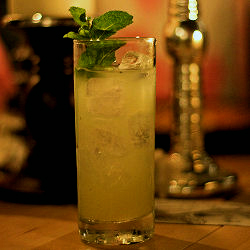 I feel downright terrible that it’s taken me this long to tell you about the fabulous time we had last month in Seattle at Le Mixeur, the exclusive soirée organized by the Munat Bros, Ted & Charles. But in my defense, it’s taken me this long to figure out how to explain it without sounding like I’m bragging. Because, dear reader, saying Le Mixeur is a cocktail party is like calling the Titanic a boat: Technically accurate, but completely missing the point both in scale and impact.
I feel downright terrible that it’s taken me this long to tell you about the fabulous time we had last month in Seattle at Le Mixeur, the exclusive soirée organized by the Munat Bros, Ted & Charles. But in my defense, it’s taken me this long to figure out how to explain it without sounding like I’m bragging. Because, dear reader, saying Le Mixeur is a cocktail party is like calling the Titanic a boat: Technically accurate, but completely missing the point both in scale and impact.
We’d read about these fabulous shindigs, jealously drooling over tales of drinks created by some of the West Coast’s finest mixological masterminds. But somehow — despite having ingratiated ourselves to the Munats both at the Zig-Zag and at Tales of the Cocktail — we’d never managed to sync our travel plans to their social calendar. Eventually, we hit the jackpot, scoring an invite to Le Mixeur Cinq on a weekend when we had no other obligations; away we flew.
On our first night in Seattle, we dropped in on Keith Waldbauer skulking in his lair at Union, one of our all-time favorite Seattle dining spots. We’d read that Keith had contributed a recipe to the Mixeur menu, and we asked him to tell us about his inspiration for the drink that would be served to dozens — if not hundreds — of serious cocktailians the following night.
“Oh… you’re going to Le Mixeur?” he asked with a gleam in his eye. “You’ll have to tell me how my drink tastes. I just sent them a recipe and didn’t even try it.”
Was he pulling our leg? You never know with Waldbauer. No sir, you never know with a man like that.
The next night, we made our way to a warehouse loft in SoDo, in the ominously empty streets bathed in the blue glow of Qwest Field. After climbing flight after flight of stairs, our efforts were rewarded. The white-walled loft opened out and up and away, revealing a happy hubbub. Our eyes darted from walls hung with eclectic art to the oh-my-god-impressive bar in the corner, where professional mixologists and a few determined amateurs shook and poured for the flowing crowd. In an open mezzanine above, the DJ nodded and smiled as the beat kicked in; a belly dancer took the floor, gyrating for the loudly appreciative audience.
The bar was stacked deep and thick as folks studied the night’s menu and waited patiently. We quickly found Charles Munat, and weasled our way into a couple of drinks after what we later realized was a uniquely short interval. Happily, the crowd was full of plenty of friends, as well as many familiar faces from bars both near and far. And the gods of mixology obviously watch over fools and drunks, because Keith’s drink — a minty, gin-based, tall sour with a Chartreuse float, which he’d dubbed the Aristocrat Swizzle — was every bit as perfect as the setting.
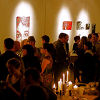
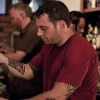
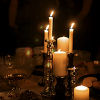
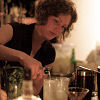
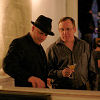
Aristocrat Swizzle
– Keith Waldbauer
1-3/4 oz gin
3/4 oz lime juice
10 mint leaves
dash simple syrup
1 barspoon green Chartreuse
Muddle mint and syrup in a mixing glass. Add gin and lime juice, and shake with ice. Strain into an empty Collins glass, fill with crushed ice, and top with a Chartreuse float. Garnish with a sprig of mint.
bar culture, Drink of the Week, drinks, Seattle
2 Comments »




Posted by Anita on 11.19.08 11:31 PM
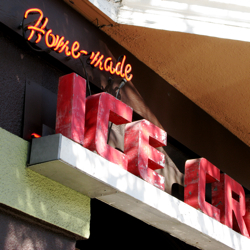 What do you do when one of your favorite foodies comes to town, and specifically mentions wanting to stroll through The Mission? Why, you plan an itinerary that takes you past some of the neighborhood’s favorite places to buy delicious treats!
What do you do when one of your favorite foodies comes to town, and specifically mentions wanting to stroll through The Mission? Why, you plan an itinerary that takes you past some of the neighborhood’s favorite places to buy delicious treats!
After shopping our way through the Ferry Plaza Farmers Market together, we left Laura to explore on her own for a few hours. (We hit Rainbow Grocery for a few staples, then headed home to put our perishables in the fridge.) We met up at high noon at 16th Street BART. Seeing as how it had been ages since we stuffed ourselves with Mexican breakfast at Primavera, we decided a traditional San Francisco burrito was in order. We stopped at Taqueria El Castillito — an old favorite, but definitely not local, sustainable, or organic in any way — and fortified ourselves with burritos and a torta, and a few bottles of Mexican cane-sugar sodas.
Back out into the bright sunshine — it’s always sunny in The Mission, but Saturday was unseasonably hot — we trekked down Mission to 18th. Trying to keep to the shady side of the street, we pointed out the retaurant row that is 18th and Guerrero (Farina, Tartine Bakery, Delfina, and Pizzeria Delfina) but did not stop to join the monster queues. We’d really just planned to peek into Bi-Rite Creamery, but the short line — full of surprisingly happy ‘No on 8‘ protesters — and list of fabulous flavors tempted us. We couldn’t let Laura leave San Francisco without a taste of the famous Salted Caramel ice cream, could we? (Cameron also sampled the malted vanilla with peanut brittle, just to make sure we’d covered all the bases.)
Across the street, Bi-Rite Market was sampling their Thanksgiving offerings from a catering station on the sidewalk. We smelled the heavenly aromas, but couldn’t even consider a nibble. We pressed inside the store along with everyone else in the entire neightborhood, taking a peek at all the fabulous local produce and the justifiably famous deli case. (I still don’t understand how Sean and DPaul lived around the corner for years without weighing 300 pounds. I’d never cook!)
Backtracking to Valencia Street, we strolled past Range — where we’d enjoyed a fabulous dinner the previous night — and popped into Lucca, one of the last remaining vestiges of the Mission’s Italian heritage. We browsed the aisles, admiring the terrific assortment of goodies, then headed back out into the street. I think I always knew that Lucca makes their ravioli on the premises, even noted the minuscule factory visible through the picture window along Valencia, but I’d never timed it right to see the process in action until this week. We stood with our noses pressed to the glass for what must have been half an hour, watching as a pair of flour-dusted pasta makers heaved giant wads of dough through an industrial sheeter, then picked them up like so much dirty laundry and magically unfolded them along a table the size of most San Francisco living rooms. (I could descibe the whole process, but Laura’s slideshow does a much better job.)
We picked up the pace and continued down Valencia to 23rd, then down Mission to 24th. After a quick stroll through the Mexican produce stalls and flower shops, we stopped into Philz to let Cameron caffeinate himself with a fine Turkish-style fiter-drip blend, while Laura and I rested our eyes and feet in the cool, dim surroundings.
Our last stop took us to a rendezvous with some of our fellow bloggers at Mission Pie. We were nearly stuffed, but somehow made room to share a slice of double-crust apple pie and another of pear-raspberry galette. When Jen arrived, she showed us the error of our ways, generously offering nibbles of the godly walnut pie (with a gooey center like pecan pie); I now understand why people drive across town to buy a slice. We sat at a big table together in the now-waning afternoon sun, marveling at all the shop’s gorgeous, quirky details — a map of the farms that sell their produce to the pie-makers, a collection of antique egg scales, and some of the coolest light fixtures in the city — chatting about everything from Yves St. Laurent to antique tractors to …well, food, of course.
If we’d only had an extra stomach, we could have kept walking all day.
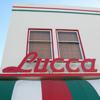
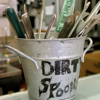
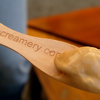
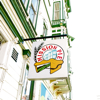
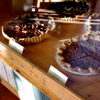
Taqueria El Castillito
2092 Mission Street (x17th)
San Francisco, CA 94110
415.621.3428
Bi-Rite Creamery
3692 18th Street (x Dolores)
San Francisco, CA 94110
415.626.5600
Bi-Rite Market
3639 18th Street (x Dolores/Guerrero)
San Francisco CA 94110
415.241.9760
Lucca Ravioli Company
1100 Valencia Street (x 22nd)
San Francisco, CA 94110
415.647.5581
Philz Coffee
3101 24th Street (x Folsom)
San Francisco, CA 94110
415.875.9370
Mission Pie
2901 Mission Street (x 25th)
San Francisco, CA 94110
415.282.4PIE
coffee & tea, dessert, Italian, Mexican, other blogs, The Mission
7 Comments »




Posted by Anita on 11.14.08 1:15 PM
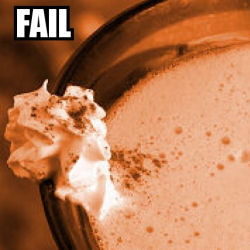
I’m having a turkey day get-together and wanted an appropriate drink. I’d like something I can serve in a martini glass, fancy shmancy cocktail thing. A guest suggested, um, I can barely type this — pumpkin pie martini — and I immediately had to shoot that down.
Help!
– Pumpkin-Averse Party Instigator
Dear PAPI:
What is it with the onslaught of pumpkin drinks this year? I mean, I love me some pumpkin pie, but …gah! Leave the whipped-cream garnish for the dessert table, please.
Thankfully, there are plenty of festive drinks that fit the bill for Thanksgiving that do not involve canned squash. Two of our favorite options from the Drink of the Week archives would be perfect for your holiday bash. They’re both certified crowd-pleasers, full of holiday flavors, and relatively low on the booze — a good idea at parties so casual drinkers don’t end up face down in the cranberry sauce. Best of all, you should be able to find all of the ingredients at your local Beverages & More, or any other well-stocked liquor store.
Have a happy Thanksgiving, and do let us know how it goes!
– Anita & Cameron
—-
Oh, Henry!
– Originally blogged 11/23/07 — click for photos and details
1-1/2 oz bourbon
1-1/2 oz spicy ginger ale (we like Blenheim)
3/4 oz Benedictine
Stir all ingredients in an ice-filled mixing glass, and strain into a cocktail glass. Garnish with a piece of star anise or an orange twist.
Now, I know a lot of casual drinkers might be wary of the bourbon. But be strong: A cocktail is like a dog — you can show no fear! I had three bourbon-haters begging me for the recipe at the last party we served these at. But do try to find Blenheim or another spicy ginger ale; Canada Dry and its ilk is too chemical-y and even the lovely Fever-Tree is too tame.
Make sure you grab Benedictine and not B&B (which is pre-mixed benedictine & brandy). The bottles look nearly identical and they’re often shelved together.
—
Falling Leaves
– Originally blogged 10/6/06 — click for photo and details
1 oz Clear Creek pear eau de vie
– or substitute pear vodka; Clear Creek is tricky to find outside of the West Coast
2 oz Trimbach Riesling wine
1/4 oz honey syrup
– equal parts of honey and water, heated together and then cooled
1/2 oz Orange curacao (such as Cointreau)
a dash of bitters, preferrably Peychaud for the rusty color and spice
Measure all ingredients into cocktail shaker, add ice, and shake well. Strain into a cocktail glass, and garnish with a whole piece of star anise or a sage leaf.
Drink of the Week, drinks, holidays & occasions, recipes
9 Comments »




Posted by Anita on 11.10.08 12:35 PM
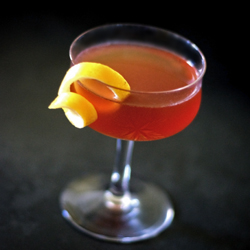 We’re no strangers to homemade cocktail ingredients. We’ve been making limoncello (and other citrus liqueurs) for ages, along with nocino, alkermes, plum brandy, and plenty of other infusions. We’ve simmered up our own grenadine, brewed a batch or two of ginger beer, steeped jar after jar of cocktail cherries, and infused more flavored syrups than any reasonable person’s fridge can hold.
We’re no strangers to homemade cocktail ingredients. We’ve been making limoncello (and other citrus liqueurs) for ages, along with nocino, alkermes, plum brandy, and plenty of other infusions. We’ve simmered up our own grenadine, brewed a batch or two of ginger beer, steeped jar after jar of cocktail cherries, and infused more flavored syrups than any reasonable person’s fridge can hold.
Last summer, we hit upon a new favorite: infused brandy using the excess pears from our friends’ tree. Since it’s an infusion, rather than distilled pear cider, our homemade drink is closer to a pear-brandy liqueur — like Belle de Brillet — than to a potent poire william eau de vie or the grappa-style Clear Creek pear brandy. We’ve mostly sipped it neat or mixed into bubbly, with or without a little simple syrup. But there’s no reason why it wouldn’t be a great mixing ingredient… especially as it doesn’t really improve with age, and in fact deteriorates fairly quickly after the initial infusion.
 There aren’t many cocktails that call for pear spirits, but there are plenty that use calvados and applejack to great effect. One such drink, the Jack Rose, dates to the pre-Prohibition era, and was especially popular in the Northeast where applejack was distilled in great quantity. Many theories abound as to the drink’s name origins, but it seems pretty likely that it’s Jack from booze and Rose from the color, as opposed to any gangster or bartender-nickname references.
There aren’t many cocktails that call for pear spirits, but there are plenty that use calvados and applejack to great effect. One such drink, the Jack Rose, dates to the pre-Prohibition era, and was especially popular in the Northeast where applejack was distilled in great quantity. Many theories abound as to the drink’s name origins, but it seems pretty likely that it’s Jack from booze and Rose from the color, as opposed to any gangster or bartender-nickname references.
The usual recipes for the Jack Rose are split fairly well between lemon and lime juice. When using applejack, I think either option is pleasant, though I will admit a small preference for lime when mixing the stronger Laird’s Bonded. But if you’re making the switch to pear brandy, definitely go with lemons — and Meyer lemons, if you can find them — as the subtler pear flavors are lost amidst lime’s extra tartness.
With a slight change to the more-Frenchified pear brandy, we christen our variation the Jacques Rose. It’s made with all home-made or home-grown ingredients, in honor of Mixology Monday “Made From Scratch,” hosted by The Pegu Blog.
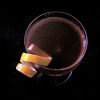
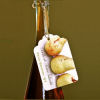
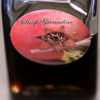
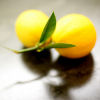
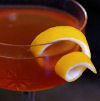
Jacques Rose
2-1/2 oz pear brandy (or substitute 1-1/2 oz brandy + 1 oz poire william)
3/4 oz lemon juice
2-3 dashes grenadine
Shake with ice, and strain into a chilled cocktail glass. Garnish with a lemon twist.
drinks, Mixology Monday, other blogs, preserving & infusing, recipes
3 Comments »




Posted by Anita on 11.07.08 7:48 PM
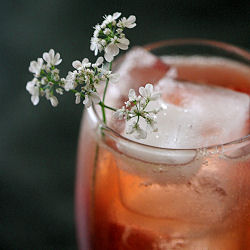 In case you’ve wondered why I’m blogging my heart out — especially after such a prolonged drought — I’m semi-covertly participating in National Blog Posting Month (better known as NaBloPoMo), a writing exercise that spun off from National Novel Writing Month.
In case you’ve wondered why I’m blogging my heart out — especially after such a prolonged drought — I’m semi-covertly participating in National Blog Posting Month (better known as NaBloPoMo), a writing exercise that spun off from National Novel Writing Month.
I haven’t officially signed up, but I’ve challenged myself to post every day this month, both to clear out the backlog of posts and photos lingering in the drafts folder, and to practice a little self-discipline. I figure if I can post seven days a week for 30 days, then the old three-times-a-week schedule will seem like a walk in the park.
—-
Way the heck back in August, I accepted a very interesting, but very unorthodox freelance assignment. Jean Aw — the brains behind NOTCOT and Liqurious — hired me for a combination recipe development / cocktail photography gig. That alone is pretty out there; most jobs are one or the other. But the angle of the job made it even more bizarre: On a dare, we agreed to come up with three cocktails based on yogurt flavors… although mercifully not containing any actual yogurt. (You can read the incredibly funny story behind it in Jean’s own words.)
The cocktails finally made their debut on NOTCOT last week. Alas, it’s too late in the year to try out my favorite of the three: the Sweet Summer Revival (fresh peach, green-tea-infused vodka, and Grand Marnier), but we’ll bring it back around for a sample in 2009. And already the weather seems a little too dreary for the citrusy Bee Cool (honey, lemon, plum brandy, creme de violette, and lavender soda).
But the third drink in the set seems more seasonally appropriate. The White Flower Bramble takes its inspiration from Rachel’s berry-jasmine flavor called “Glow”. It’s based on a popular English drink that marries blackberry liqueur and gin, but replaces the usual simple syrup with St-Germain liqueur for a floral touch. We’ve still got raspberries at our farmers market, but if they’re gone where you are, fresh cranberries could easily take their place.
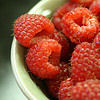
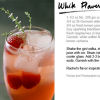
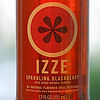

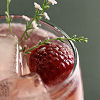
White Flower Bramble
1-1/2 oz No. 209 gin
3/4 oz St-Germain elderflower liqueur
3/4 oz fresh lemon juice
berry soda (such as Izze blackberry or Fizzy Lizzy cranberry)
fresh raspberries or cranberries
Shake the gin/vodka, elderflower liqueur, and lemon juice with ice. Strain into an ice-filled highball or cooler glass. Add 2-3 berries, and top with blackberry soda. Garnish with an edible white flower, such as chamomile or lemon verbena.
Drink of the Week, drinks, other blogs
1 Comment »




Posted by Anita on 11.05.08 8:02 AM
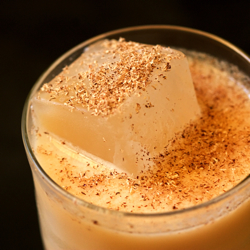 Red state or blue state, I have a funny feeling there will be many folks in a sickly-green state this morning. Democrats were perhaps a little too far into the celebratory Champagne last night, while Republicans were drowning their collective sorrows. (Not, we should hasten to add, that there’s anything wrong with that.)
Red state or blue state, I have a funny feeling there will be many folks in a sickly-green state this morning. Democrats were perhaps a little too far into the celebratory Champagne last night, while Republicans were drowning their collective sorrows. (Not, we should hasten to add, that there’s anything wrong with that.)
Thankfully for all of us, the medical community has fairly well established that the best cure for a hangover — campaign-induced or otherwise — is a nip of the same posion that got you in this sorry state. Even if you sleep ’til noon, it probably seems a little too early to pop another bottle of bubbly, or mix up anything complicated. But a Brandy Milk Punch… that you can make with one eye shut and the other just barely open.
It’s a simple enough concoction, and one that you can almost certainly make with ingredients you have around the house. Milk, brandy, simple syrup or sugar in a pinch… we’re not going to be dogmatic here; It’s rough medicine, after all, not a mixology contest. We’ve even been known to keep agave nectar on hand for those times we’re too lazy or hung over to make simple syrup. Anyway… The milk gets a little protein and fat in your system, good enough to tide you over until you’re feeling well enough to crawl outside in search of hash browns.
I know nobody’s in the mood for a history lesson, but in case you need a referral: Most folks trace the Brandy Milk Punch’s roots — or at the very least, its popularity — to New Orleans, a city that certainly knows more than a bit about surviving the morning after.
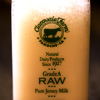
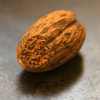
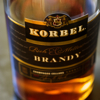
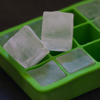
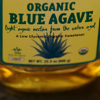
Brandy Milk Punch
2 oz brandy
1/2 oz simple sugar (or 1/2 tsp sugar)
whole milk
nutmeg
In a tall glass or double Old Fashioned glass, stir the sugar and brandy together to dissolve. Add ice cubes to fill the glass to the rim, then top with milk. Stir gently to combine, then top with grated nutmeg.
breakfast, drinks, recipes
7 Comments »




Posted by Anita on 11.04.08 9:40 AM
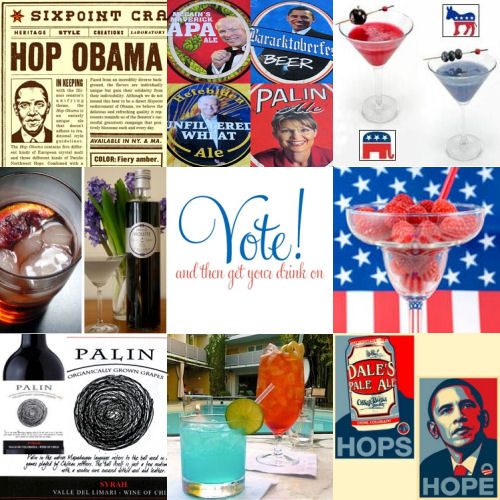
Just in case you need help picking something to drink tonight — other than Champagne to toast with or beer to cry in — while you’re watching the election returns, we’ve got a slew of options over at Liqurious to help you out.
Some of the posts even feature actual, real-live cocktails, as opposed to the annoying onslaught of sickly sweet ‘Obama-ritas’ and ‘Maverick-tinis’ that seems have clogged every drink-blogger’s inbox for the last three months.
Goodness knows, we could all use a strong one after the this endless campaign.
—
PS: You voted, right? RIGHT!?
drinks, holidays & occasions, other blogs
2 Comments »




Posted by Anita on 10.31.08 7:07 AM
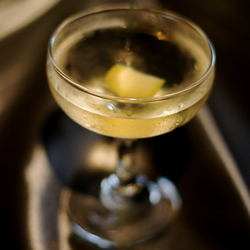 It’s been a good year or two for vintage cocktail buffs. After wandering in the metaphorical desert for so long in search of lost ingredients, our oddball desires have finally been vindicated. Every few months, a flurry of spirits are resurrected from the dustbins, opening up another chapter of classic recipes for experimentation.
It’s been a good year or two for vintage cocktail buffs. After wandering in the metaphorical desert for so long in search of lost ingredients, our oddball desires have finally been vindicated. Every few months, a flurry of spirits are resurrected from the dustbins, opening up another chapter of classic recipes for experimentation.
The latest no-longer-missing link is genever, also known in the old cocktail manuals as Holland gin. Of course, genever’s never really gone away. Industrious cocktail hounds have traveled to the Netherlands and brought back suitcases full of the juniper-laced spirit, or scoured the dusty shelves of liquor stores in search of the odd bottle or two. And the drink-nerdy among us will vouch that San Francisco’s very own Anchor Distilling — of Junipero gin and Old Potrero whiskey fame — produces their own genever-ish expression known as Genevieve.
But true Dutch-style genever has been rather thin on the ground in the States, at least until this fall. At the West Coast reintroduction of Bols Genever, I had a chance to chat with cocktail historian David Wondrich, most recently known as the author of the top-notch Jerry Thomas biography, Imbibe!.
Accustomed to a fair bit of cynicism in the professional cocktail world, I was struck by how genuinely excited Wondrich seems about this re-release.
“When you make some of the old [Thomas] drinks with London dry gin,” says Wondrich, “You take a sip and think ‘Hmm, tastes must have changed in the last 100 years’ and dump it out. But when you mix them with genever — which was the gin the bartenders were using in those days — the flavors suddenly click.” Running down the Thomas drinks roster with Wondrich, you get a sense of how a steady supply of good genever could change things dramatically for vintage cocktail aficionados; perhaps 19th-century cocktails will be the next big thing after all.
If you’re expecting genever to taste like a typical English gin, you’ll be taken aback; its flavor is closer to a young whiskey minus any of the woody notes, or perhaps a silver tequila without agave’s horse-blanket overtones. Though genever is commonly regarded as the forerunner of gin, most gin is little more than herb-infused vodka, redistilled to remove harsh flavors and cloudiness. Traditional genever starts out as maltwine, which in turn begins as a beer-like mash. Bearing all this in mind, Bols has taken pains to ensure that their genever is not labeled or marketed as a gin, instead pushing the government to recognize it as a distinct spirits class. On the other side of the Atlantic, genever benefits from a new European Union location-protected appellation — analgous to Champagne or Cognac or Roquefort — mandating production within the Netherlands and adjoining low-countries regions in order to bear the name.
(Oh, and about that name? It’s pronounced gen-EE-vrr, as opposed to JEN-eh-ver. Yes, I’ve been saying it wrong all these years, too, so don’t feel too bad.)
And oh my, what a gorgeous bottle. Bols tells us it’s the first use of smoked glass in a spirits bottle, manufactured using a technique that was not as easy to borrow from the perfume world as they had hoped. The logotype evokes the beautiful calligraphy found on the dark windows of old Dutch cafes.
Bols plied us with a parade of cocktails that afternoon, but my favorite — a preference shared by many of the folks I chatted with — was the Holland Gin Cocktail. Actually, Bols styles it the Improved Holland Gin Cock-Tail on their site, but since their recipe lacks any maraschino, I don’t think that’s actually the correct nomenclature. (I won’t bore you with the details here, but if you’re curious, I blathered about it elsewhere.) However you call it, this simply elegant combination showcases genever’s taste to a T, highlighting just how much you’re missing if you make many of the old drinks with plain-old gin.

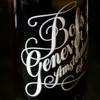

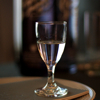

Holland Gin Cocktail
– Jerry Thomas, by way of David Wondrich
2-3 oz Bols Genever
2-3 dashes rich (2:1) simple syrup
2 dashes orange bitters
1 dash dry orange curaçao
Prepare a chilled coupe or cocktail glass by wetting the rim with a lemon slice. Stir the drink ingredients with large ice cubes and strain into the prepared glass. Cut a large coin-sized zest of lemon directly over the cocktail, spraying the oils over the drink and running the zest around the rim before dropping it in the drink.
Drink of the Week, drinks, recipes
5 Comments »




Posted by Cameron on 10.13.08 10:46 PM
 If there is a drink out there with fewer redeeming qualities than the Jäger Bomb, I can’t imagine what it is. Seriously folks, this drink is a bad idea. It tastes like cough syrup, it’s loaded with sugar, it packs enough caffeine to instantly add fifty points to your heart rate, and one of the main ingredients is made entirely of industrial chemicals.
If there is a drink out there with fewer redeeming qualities than the Jäger Bomb, I can’t imagine what it is. Seriously folks, this drink is a bad idea. It tastes like cough syrup, it’s loaded with sugar, it packs enough caffeine to instantly add fifty points to your heart rate, and one of the main ingredients is made entirely of industrial chemicals.
And so, in honor of Stevi’s Mixology Monday topic, Guilty Pleasures, I’m horrified to share with you that I’m completely, utterly addicted to the Trailer Trash Speedball, the Turbojäger, the Flying Hirsch, La Perla Negra: The Jäger Bomb.
I picked up this dirty little habit during my tour of duty as a guitar player for Seattle-area cover band Bad Alibi. For the first three months, I was fastidious about not drinking during performances. To tell the truth, for the first month, I was too panicked to even think about trying to play with a buzz on, which amused my band mates tremendously. They rarely got out of control, but every set was accompanied by beer and, to tell the truth, if our drummer wasn’t stoned, he couldn’t keep time at all.
Before the third and final set of the evening, one of the Alibi Boys would usually buy a round of Jäger Bombs. At first I declined to take part in the toxic trainwreck, but eventually I thought, “Don’t knock it if you haven’t tried it.”
Like any destructive obsession, ritual is an important part of the Jäger Bomb. A shot of Jägermeister, an herbal liqueur, is served next to a pint glass containing half a can of Red Bull energy drink. You drop the shot glass into the pint glass and chug the mixture. Think of it as a millennial boilermaker.
As I climbed back on stage after my first ever Jäger Bomb, I immediately understood the appeal. Our third sets usually ran from midnight to 1:45am. Fridays weren’t too bad, but we always played two nights in a row and the third set on Saturday could be tough. No matter how big the crowd was, by 12:30, the entire room was completely blasted. By 1am, the energy would start to fall off, and by 1:30, the only people upright were usually us and the bar staff.
 This is all by way of saying that if you run around playing high voltage rock and roll late at night, the Jäger Bomb starts to make a lot of sense. One produces a high, fine, jittery feeling, and two will definitely get your motor running. Drink three in quick succession and you might as well hand the bartender your credit card and have them call the cops now, just to save time.
This is all by way of saying that if you run around playing high voltage rock and roll late at night, the Jäger Bomb starts to make a lot of sense. One produces a high, fine, jittery feeling, and two will definitely get your motor running. Drink three in quick succession and you might as well hand the bartender your credit card and have them call the cops now, just to save time.
After about a year and a half of playing 5 hours a night, 2 nights a week, 3 weekends a month in roadhouses anywhere from 45 minutes to 2 hours outside the city, all while holding down a full time corporate day job, my attitude towards rock godhead changed. The crowds were getting smaller, the drives were getting longer, and there is absolutely nothing fun about breaking down the stage at 2am. When I left the band, I mostly stopped drinking Jäger Bombs, as it’s not the sort of thing that you order in polite company.
But every now and then I let the inner Neanderthal come out to play. I drop the shot into the glass, and fire back the mixture. As the tight rush crawls up my spine, I close my eyes and remember when the lights flashed, the fog billowed, and—with one foot on the monitor and a snarl on my lips—I delivered the mighty rock thunder to a sea of dancing hooligans.

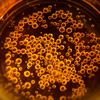
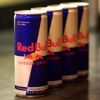
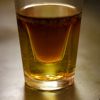

Jäger Bomb
4oz of energy drink (roughly 1/2 can of Red Bull)
1 shot Jägermeister
Pour the energy drink in a pint glass. Drop the shot in the pint glass and drink the whole mess down. Rock on.
bar culture, Drink of the Week, drinks, Mixology Monday, recipes, Seattle
13 Comments »




Posted by Anita on 09.15.08 3:41 PM
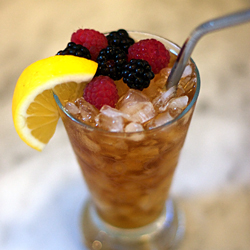 This month’s edition of Mixology Monday, hosted by Dinah and Joe at Bibulo.us, focuses on 19th century libations.
This month’s edition of Mixology Monday, hosted by Dinah and Joe at Bibulo.us, focuses on 19th century libations.
We’re no strangers to this era: Previous editions of Drink of the Week have covered the venerable Mint Julep (1824), Sazerac (1859), Martinez (1862), Manhattan (1870), Ramos Gin Fizz (1880s), Whiskey Sour (pre-1888), Widow’s Kiss (1895), and Horse’s Neck (1897). But, to a greater or lesser degree, all of these drinks have remained well-loved throughout the years.
But what of the Sherry Cobbler, the late 19th century’s most popular drink? What became of the darling that inspired such adulation?
Gin-sling, cock-tail, mint-julep, are about as vulgar as blue ruin and old tom at home; but sherry cobbler is an affair of consideration.
— “Canada and the Canadians“, Richard Henry Bonnycastle (1848)
Most sources date the origins of the Sherry Cobbler to the 1840s — the height of its popularity, to be sure. Digging through web references, I found a mention of it in Washington Irving’s Knickerbocker’s History of New York, Complete, a satirical record of early New York City, first published in 1809:
[Residents of Maryland] lay claim to be the first inventors of those recondite beverages, cock-tail, stone-fence, and sherry-cobbler, and to have discovered the gastronomical merits of terrapins, soft crabs, and canvas-back ducks.
It’s surely a tongue-in-cheek admonition, as the word “cocktail” wouldn’t have been known in the colonial era that our fictional historian details. But despite his tomfoolery, Irving thought that cobblers were sufficiently well-known in 1809 that he could reference it without description — a full 30 years before cobbler-mania’s peak.
There’s hardly a peep about cobblers until the late 1830s, but mid-century publications are chock full of evidence that Sherry Cobbler took England by storm soon thereafter. By 1844, no less a light than Charles Dickens name-checks the drink in his serial novel Martin Chuzzlewit, an otherwise scathing indictment of all things American. In one chapter, the title character’s traveling companion Mark Tapley supplies him with a restorative tipple:
He produced a very large tumbler, piled up to the brim with little blocks of clear transparent ice, through which one or two thin slices of lemon, and a golden liquid of delicious appearance, appealed from the still depths below, to the loving eye of the spectator.
 ‘What do you call this?’ said Martin.
‘What do you call this?’ said Martin.
But Mr. Tapley made no answer; merely plunging a reed into the mixture — which caused a pleasant commotion among the pieces of ice — and signifying by an expressive gesture that it was to be pumped up through that agency by the enraptured drinker.
Martin took the glass with an astonished look; applied his lips to the reed; and cast up his eyes once in ecstasy. He paused no more until the goblet was drained to the last drop.
‘This wonderful invention, sir,’ said Mark, tenderly patting the empty glass, ‘is called a cobbler. Sherry cobbler when you name it long; cobbler, when you name it short.
Presumably upon reading Dickens’s account of ecstasy on ice, British university students were swept up in a cobbler craze. Despite initial problems with substandard ice sourced from fishmongers, the drink’s popularity soared, finding its way into genteel parlors and private gentlemen’s clubs. By 1862, so firmly was the cobbler established that Jerry Thomas devoted an entire section of his Bartender’s Guide to different recipes for cobblers made with sherry, claret, Champagne, whiskey, and sweet wines: hock, catawba, and Sauternes. Thomas tailors ingredients to the base spirit: Often there are oranges (peel or pieces), other times pineapple; an occasional sweet liqueur joins dissolved sugar for added sweetness.
A drink that could be enjoyed by gentlefolk without incurring scorn, it’s only fitting that the cobbler would have its own trinkets. The cobbler popularized the drinking straw; before the 1888 invention of the wound-paper model, hollow reeds or even macaroni strands were used! Cobblers were also, according to some highly reputable sources, the first drinks where ingredients were shaken with ice. I haven’t been able to find primary sources to support that observation, but it’s clear that the Sherry Cobbler craze of the mid-1800s was indeed the force that propelled cocktail shakers into every bar of any size. To this day, a three-piece cocktail mixer with a built-in strainer is known as a cobbler shaker.
Unlike many antique cocktails, this one’s still quite delectable to modern palates; the fresh-fruit garnish and wine base seem downright contemporary. Rescuing this drink from near-obscurity, a new breed of bartenders are cranking up variations coast to coast.
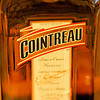
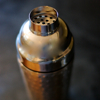
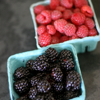
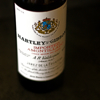
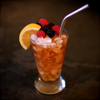
Sherry Cobbler
3 oz medium-dry sherry (such as Oloroso or Amontillado)
1/2 oz Cointreau
1/2 oz simple syrup (or to taste)
2 lemon or orange wedges
berries or other seasonal fruit, for garnish
Squeeze one citrus wedge into an ice-filled cocktail shaker. Add the spent citrus wedge, sherry, Cointreau, and simple syrup, and shake until very cold. Strain into a cobbler glass filled with crushed ice; garnish with the remaining citrus wedge and a riot of fruit, and serve with a straw.
Drink of the Week, drinks, Mixology Monday, recipes
11 Comments »




 I feel downright terrible that it’s taken me this long to tell you about the fabulous time we had last month in Seattle at Le Mixeur, the exclusive soirée organized by the Munat Bros, Ted & Charles. But in my defense, it’s taken me this long to figure out how to explain it without sounding like I’m bragging. Because, dear reader, saying Le Mixeur is a cocktail party is like calling the Titanic a boat: Technically accurate, but completely missing the point both in scale and impact.
I feel downright terrible that it’s taken me this long to tell you about the fabulous time we had last month in Seattle at Le Mixeur, the exclusive soirée organized by the Munat Bros, Ted & Charles. But in my defense, it’s taken me this long to figure out how to explain it without sounding like I’m bragging. Because, dear reader, saying Le Mixeur is a cocktail party is like calling the Titanic a boat: Technically accurate, but completely missing the point both in scale and impact.




















































